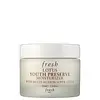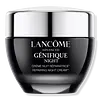What's inside
What's inside
 Key Ingredients
Key Ingredients

 Benefits
Benefits

 Concerns
Concerns

 Ingredients Side-by-side
Ingredients Side-by-side

Water
Skin ConditioningGlycerin
HumectantPropylene Glycol Dicaprylate/Dicaprate
EmollientPentylene Glycol
Skin ConditioningCetearyl Alcohol
EmollientCaprylic/Capric Triglyceride
MaskingCetearyl Isononanoate
EmollientBetaine
HumectantSteareth-21
CleansingNelumbo Nucifera Extract
Skin ConditioningCitrus Limon Peel Oil
MaskingCucumis Sativus Fruit Extract
EmollientAverrhoa Carambola Leaf Extract
HumectantTocopherol
AntioxidantSilica
AbrasiveBehenyl Alcohol
EmollientCetearyl Glucoside
EmulsifyingSorbitol
HumectantDimethicone
EmollientSodium PCA
HumectantCarbomer
Emulsion StabilisingCaprylyl Glycol
EmollientButylene Glycol
HumectantTromethamine
BufferingCetyl Alcohol
EmollientStearyl Alcohol
EmollientSodium Hyaluronate
HumectantXanthan Gum
EmulsifyingLauroyl Lysine
Skin ConditioningAdenosine
Skin ConditioningGlucose
HumectantTetrasodium EDTA
Sodium Metabisulfite
AntioxidantPotassium Sorbate
PreservativeSodium Benzoate
MaskingPhenoxyethanol
PreservativeLimonene
PerfumingCitral
PerfumingWater, Glycerin, Propylene Glycol Dicaprylate/Dicaprate, Pentylene Glycol, Cetearyl Alcohol, Caprylic/Capric Triglyceride, Cetearyl Isononanoate, Betaine, Steareth-21, Nelumbo Nucifera Extract, Citrus Limon Peel Oil, Cucumis Sativus Fruit Extract, Averrhoa Carambola Leaf Extract, Tocopherol, Silica, Behenyl Alcohol, Cetearyl Glucoside, Sorbitol, Dimethicone, Sodium PCA, Carbomer, Caprylyl Glycol, Butylene Glycol, Tromethamine, Cetyl Alcohol, Stearyl Alcohol, Sodium Hyaluronate, Xanthan Gum, Lauroyl Lysine, Adenosine, Glucose, Tetrasodium EDTA, Sodium Metabisulfite, Potassium Sorbate, Sodium Benzoate, Phenoxyethanol, Limonene, Citral
Water
Skin ConditioningBifida Ferment Lysate
Skin ConditioningGlycerin
HumectantDicaprylyl Ether
EmollientPentylene Glycol
Skin ConditioningPolyglyceryl-6 Distearate
EmulsifyingPropanediol
SolventCetyl Esters
EmollientJojoba Esters
EmollientAmmonium Polyacryloyldimethyl Taurate
Emulsion StabilisingBehenyl Alcohol
EmollientOctyldodecanol
EmollientAcacia Decurrens Flower Cera
EmollientHelianthus Annuus Seed Cera
EmollientHelianthus Annuus Seed Oil
EmollientPolymnia Sonchifolia Root Juice
Skin ConditioningCeramide NP
Skin ConditioningAlpha-Glucan Oligosaccharide
CleansingSodium Hyaluronate
HumectantSodium Hydroxide
BufferingSodium Stearoyl Glutamate
CleansingSalicyloyl Phytosphingosine
Skin Conditioning2-Oleamido-1,3-Octadecanediol
Skin ConditioningAdenosine
Skin ConditioningMannose
HumectantCoco-Caprylate/Caprate
EmollientAscorbyl Glucoside
AntioxidantHydroxyacetophenone
AntioxidantHydroxypalmitoyl Sphinganine
Skin ConditioningHydroxypropyl Starch Phosphate
Capryloyl Salicylic Acid
ExfoliatingTrisodium Ethylenediamine Disuccinate
Lactic Acid
BufferingLactobacillus
Skin ConditioningAcetic Acid
BufferingMaltodextrin
AbsorbentFaex Extract
Skin ConditioningPolyglycerin-3
HumectantPolyglyceryl-3 Beeswax
EmulsifyingCetyl Alcohol
EmollientTocopherol
AntioxidantSodium Benzoate
MaskingLinalool
PerfumingLimonene
PerfumingCitronellol
PerfumingParfum
MaskingWater, Bifida Ferment Lysate, Glycerin, Dicaprylyl Ether, Pentylene Glycol, Polyglyceryl-6 Distearate, Propanediol, Cetyl Esters, Jojoba Esters, Ammonium Polyacryloyldimethyl Taurate, Behenyl Alcohol, Octyldodecanol, Acacia Decurrens Flower Cera, Helianthus Annuus Seed Cera, Helianthus Annuus Seed Oil, Polymnia Sonchifolia Root Juice, Ceramide NP, Alpha-Glucan Oligosaccharide, Sodium Hyaluronate, Sodium Hydroxide, Sodium Stearoyl Glutamate, Salicyloyl Phytosphingosine, 2-Oleamido-1,3-Octadecanediol, Adenosine, Mannose, Coco-Caprylate/Caprate, Ascorbyl Glucoside, Hydroxyacetophenone, Hydroxypalmitoyl Sphinganine, Hydroxypropyl Starch Phosphate, Capryloyl Salicylic Acid, Trisodium Ethylenediamine Disuccinate, Lactic Acid, Lactobacillus, Acetic Acid, Maltodextrin, Faex Extract, Polyglycerin-3, Polyglyceryl-3 Beeswax, Cetyl Alcohol, Tocopherol, Sodium Benzoate, Linalool, Limonene, Citronellol, Parfum
 Reviews
Reviews

Ingredients Explained
These ingredients are found in both products.
Ingredients higher up in an ingredient list are typically present in a larger amount.
Adenosine is in every living organism. It is one of four components in nucleic acids that helps store our DNA.
Adenosine has many benefits when used. These benefits include hydrating the skin, smoothing skin, and reducing wrinkles. Once applied, adenosine increases collagen production. It also helps with improving firmness and tissue repair.
Studies have found adenosine may also help with wound healing.
In skincare products, Adenosine is usually derived from yeast.
Learn more about AdenosineBehenyl Alcohol is a type of fatty alcohol (these are different from the drying, solvent alcohols).
Fatty Alcohols have hydrating properties and are most often used as an emollient or to thicken a product. They are usually derived from natural fats and oils; behenyl alcohol is derived from the fats of vegetable oils.
Emollients help keep your skin soft and hydrated by creating a film that traps moisture in.
In 2000, Behenyl Alcohol was approved by the US as medicine to reduce the duration of cold sores.
Learn more about Behenyl AlcoholCetyl Alcohol is a fatty alcohol. Fatty Alcohols are most often used as an emollient or to thicken a product.
Its main roles are:
Though it has "alcohol" in the name, it is not related to denatured alcohol or ethyl alcohol.
The FDA allows products labeled "alcohol-free" to have fatty alcohols.
Learn more about Cetyl AlcoholGlycerin is already naturally found in your skin. It helps moisturize and protect your skin.
A study from 2016 found glycerin to be more effective as a humectant than AHAs and hyaluronic acid.
As a humectant, it helps the skin stay hydrated by pulling moisture to your skin. The low molecular weight of glycerin allows it to pull moisture into the deeper layers of your skin.
Hydrated skin improves your skin barrier; Your skin barrier helps protect against irritants and bacteria.
Glycerin has also been found to have antimicrobial and antiviral properties. Due to these properties, glycerin is often used in wound and burn treatments.
In cosmetics, glycerin is usually derived from plants such as soybean or palm. However, it can also be sourced from animals, such as tallow or animal fat.
This ingredient is organic, colorless, odorless, and non-toxic.
Glycerin is the name for this ingredient in American English. British English uses Glycerol/Glycerine.
Learn more about GlycerinLimonene is a fragrance that adds scent and taste to a formulation.
It's found in the peel oil of citrus fruits and other plants such as lavender and eucalyptus. The scent of limonene is generally described as "sweet citrus".
Limonene acts as an antioxidant, meaning it helps neutralize free radicals.
When exposed to air, oxidized limonene may sensitize the skin. Because of this, limonene is often avoided by people with sensitive skin.
The term 'fragrance' is not regulated in many countries. In many cases, it is up to the brand to define this term. For instance, many brands choose to label themselves as "fragrance-free" because they are not using synthetic fragrances. However, their products may still contain ingredients such as essential oils that are considered a fragrance.
Learn more about LimonenePentylene glycol is typically used within a product to thicken it. It also adds a smooth, soft, and moisturizing feel to the product. It is naturally found in plants such as sugar beets.
The hydrophilic trait of Pentylene Glycol makes it a humectant. As a humectant, Pentylene Glycol helps draw moisture from the air to your skin. This can help keep your skin hydrated.
This property also makes Pentylene Glycol a great texture enhancer. It can also help thicken or stabilize a product.
Pentylene Glycol also acts as a mild preservative and helps to keep a product microbe-free.
Some people may experience mild eye and skin irritation from Pentylene Glycol. We always recommend speaking with a professional about using this ingredient in your routine.
Pentylene Glycol has a low molecular weight and is part of the 1,2-glycol family.
Learn more about Pentylene GlycolSodium Benzoate is a preservative. It's used in both cosmetic and food products to inhibit the growth of mold and bacteria. It is typically produced synthetically.
Both the US FDA and EU Health Committee have approved the use of sodium benzoate. In the US, levels of 0.1% (of the total product) are allowed.
Sodium benzoate works as a preservative by inhibiting the growth of bacteria inside of cells. It prevents the cell from fermenting a type of sugar using an enzyme called phosphofructokinase.
It is the salt of benzoic acid. Foods containing sodium benzoate include soda, salad dressings, condiments, fruit juices, wines, and snack foods.
Studies for using ascorbic acid and sodium benzoate in cosmetics are lacking, especially in skincare routines with multiple steps.
We always recommend speaking with a professional, such as a dermatologist, if you have any concerns.
Learn more about Sodium BenzoateSodium Hyaluronate is hyaluronic acid's salt form. It is commonly derived from the sodium salt of hyaluronic acid.
Like hyaluronic acid, it is great at holding water and acts as a humectant. This makes it a great skin hydrating ingredient.
Sodium Hyaluronate is naturally occurring in our bodies and is mostly found in eye fluid and joints.
These are some other common types of Hyaluronic Acid:
Learn more about Sodium HyaluronateTocopherol (also known as Vitamin E) is a common antioxidant used to help protect the skin from free-radicals and strengthen the skin barrier. It's also fat soluble - this means our skin is great at absorbing it.
Vitamin E also helps keep your natural skin lipids healthy. Your lipid skin barrier naturally consists of lipids, ceramides, and fatty acids. Vitamin E offers extra protection for your skin’s lipid barrier, keeping your skin healthy and nourished.
Another benefit is a bit of UV protection. Vitamin E helps reduce the damage caused by UVB rays. (It should not replace your sunscreen). Combining it with Vitamin C can decrease sunburned cells and hyperpigmentation after UV exposure.
You might have noticed Vitamin E + C often paired together. This is because it is great at stabilizing Vitamin C. Using the two together helps increase the effectiveness of both ingredients.
There are often claims that Vitamin E can reduce/prevent scarring, but these claims haven't been confirmed by scientific research.
Learn more about TocopherolWater. It's the most common cosmetic ingredient of all. You'll usually see it at the top of ingredient lists, meaning that it makes up the largest part of the product.
So why is it so popular? Water most often acts as a solvent - this means that it helps dissolve other ingredients into the formulation.
You'll also recognize water as that liquid we all need to stay alive. If you see this, drink a glass of water. Stay hydrated!
Learn more about Water